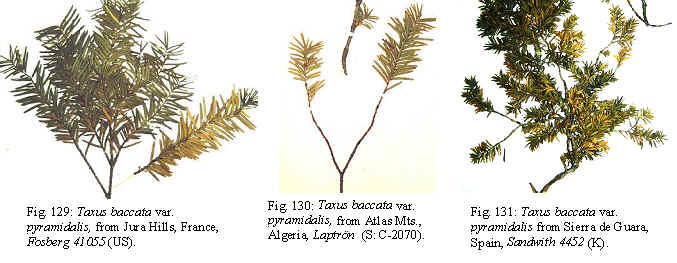|
 16i.
Taxus baccata var. pyramidalis [Ravenscroft] Lawson (Figs.
129–131), Abietineae—List Pl. Fir Tribe No. 10, 83. 1851. Taxus
baccata [f.] pyramidalis Beissner, Handb. Nadelholzk. 175.
1891.. Taxus communis pyramidalis Nelson, Pinaceae 172. 1866. Taxus
pyramidalis Severin in Möller's Deutsch. Gärt.-Zeit. 41: 227, fig.
1926. Origin of material in horticulture unknown; original herbarium
material unknown.
Neotype (designated, Spjut 2007)—France. Lananau Mutohir (Girandi), along marsh—1 Sep
1930, Tidestrom 12814, with seed at US! (US: 1528427); isoneotype
(US: 1528652).
French
yew. Distribution: Euro-Mediterranean.
Shrubs
or trees; branchlets weeping or horizontal, spreading, short and much
divided, ± fastigiate, isodichotomous, yellowish orange or yellowish
green, usually lacking leaves by the 3rd yr; bud-scales
persistent, obtuse, with a thickened or keeled midnerve, yellowish to
reddish brown; leaves radial, or closely overlapping and wide spreading
in two ranks, yellowish green on adaxial (dorsal) surface, developing an
orange tint near apex in the herbarium, or dark metallic green in one
specimen from Norway, yellowish green to greenish orange below, linear,
1.8-2.2 cm long, ca. 2 mm wide, or oblong, ca. 1.5 cm long. Male cones
not seen at maturity, buds appearing solitarily near apex of branchlets;
seed in one specimen near apex of branchlet, globose, reddish brown.
Distribution. Algeria, France, Spain, Portugal, and Norway.
Taxus baccata var.
pyramidalis is recognized by the
flexuous (or pendulous) branchlets of equal length, usually with a yellowish orange color
and loss of leaves towards the base (3rd yr), and by the
leaves spreading widely from branchlets. Some branchlets and
leaves tend to spread nearly at right angles, especially in the type, in
contrast to a much narrow spread of branchlets and leaves in var.
baccata. It is also similar to varieties elegantissima
and jacksonii by the paucity of cones, and to var. ericoides
by the radial orientation of leaves (except the type). The specimen from Norway (Gamble)
has darker green metallic leaves instead of the typical yellowish green
color. It is considered var. pyramidalis by the
wide spreading branchlets, which also appear recurved, and by the
overlapping leaves in which the leaf arrangement is most similar to the other
specimens of this variety than to other varieties.
Representative Specimens—Algeria: Atlas, Blida, Olaptin
(S: C- 2070). Portugal: Ser. Estrela, Cyrén (S: C-2058). Spain:
Huesca: Ser. Guara, Sandwith 4452 (BM). France: Jura Mts, Fosberg
41055 (US); Lananau Mutohir (Girandi), along marsh, 1 Sep 1930, Tidestrom
12814 (US: 1528652). Norway: Woods, West Delen, Gamble
28933 (K).
|